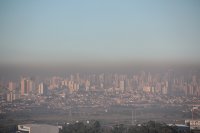The name Hong Kong means “fragrant harbor.” There is an old joke that when a plane landed at Kai Tak, Hong Kong’s former airport, and the pilots opened the doors, they would look at each other and one would say, “If it’s not you and it’s not me, this must be Hong Kong.” The harbor’s fragrance is no longer a pleasant one, and now, sadly, air pollution in Hong Kong is a common complaint as well.
For the good news first, Victoria Harbor waters have been notoriously high in E. coli bacteria for decades resulting from the practice of dumping raw sewage into the harbor after minimal filtration. Thankfully, the sewage treatment system (Harbour Area Treatment Scheme) installed in 2001 on Stonecutters Island now provides chlorination and other processing to remove most of the bacteria and other pollutants before discharging the wastewater collected from much of the city to the harbor. By 2014 the remaining raw sewage from other parts of the territory will also be piped to the treatment facility.Harbor water contamination is still often above designated safe limits, but the general level is now so much improved that the annual cross harbor swim tournament between Sam Ka Tsuen and Quarry Bay was reinstated in 2010 after a 33-year hiatus. Waters at outlying islands are generally cleaner from natural ocean cleansing actions. The Hong Kong government monitors water quality at many area beaches, indicating that the cleanest water will generally be found in Sai Kung.
So water pollution is decreasing, but air pollution is worsening. In fact, air pollution in 2012 is reported as ten times worse than in 2005. In 2009, Hong Kong airborne particulate matter was two times as high as London, Paris, Madrid, Berlin, and Los Angeles while it was half the level of Beijing, a third that of Mexico City, and a quarter of Delhi.
The government environmental protection department (EPD) monitors air quality very closely, with stations at street level in Causeway Bay, Mong Kok, and Central, and at higher elevations at eleven other stations across the island and in New Territories. Pollution is reported as an API index with a scale from 1 to 500, with “high” level from 51 to 100 considered unsafe for long-term exposure and “very high” level above 100 considered unsafe for short-term exposure for those with heart or respiratory problems. Between 2010 and 2012 there were about 150 days with an API higher than 100 at the roadside stations. General stations indicated about 30 days above 100. Areas with the least pollution are away from central Hong Kong with its high-rises creating a smog-collecting canyon.
These results are disappointing when considering anti-pollution improvement efforts in Hong Kong. Laws and enforcement have been put in place to convert the ubiquitous taxis from diesel to cleaner fuel, establish environmental compliance requirements similar to those in Europe, and convert local power plant usage from dirty coal to gas or other cleaner fuels. New laws are even in place to reduce emissions from cars idling in the streets and cruise boats docked in the harbor.
Since 1990 Hong Kong emissions of sulfur dioxide, nitrogen oxides, volatile organic compounds, and respirable suspended particulates have been reduced by one-half to two-thirds. However, the hours of reduced visibility level (smog) has gone up by a factor of four during this time. From 2010 to 2012, clear days in Hong Kong were only 57, 59, and 69 according to WHO (World Health Organization) short-term guidelines.
Much of the smog problem in Hong Kong occurs from its location near the Pearl River Delta industrial area of China with its 70,000 factories. Guangdong pollution from cars, motorcycles, and coal-powered power plants naturally drifts south. While Hong Kong and mainland China established a cooperative effort to address pollution in 2010, progress is slow.
The bottom line is that pollution in Hong Kong is bad and not getting better any time soon. Several organizations track avoidable harm in terms of doctor visits, hospital bed stays, and premature deaths. Tourism business is projected to fall off without the draw of Hong Kong’s beautiful blue skies. Property value may decrease, or at least not increase as much as in Singapore or other “clean” areas in Asia. International companies are facing increased costs related to medical expenses and lost productivity. They may also find difficulty recruiting and retaining expat employees, especially those with families with young children.

